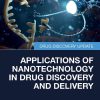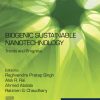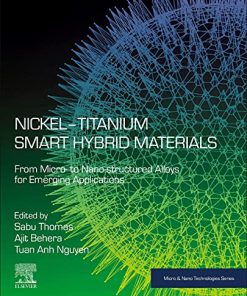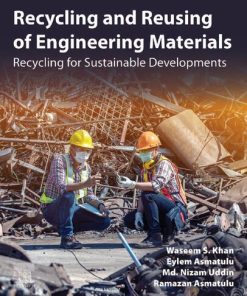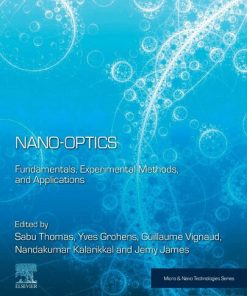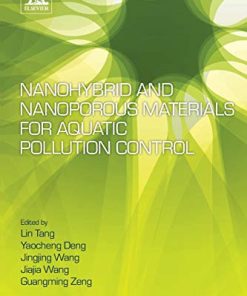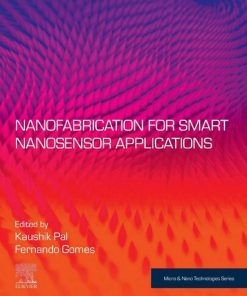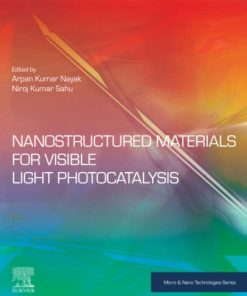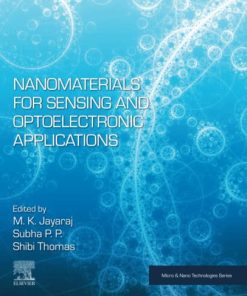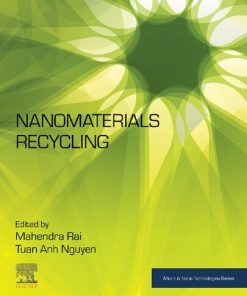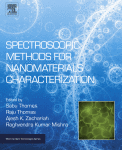(Ebook PDF) Nano Technology for Battery Recycling Remanufacturing and Reusing Micro and Nano Technologies 1st Edition by Ram Gupta, Ghulam Yasin, Tuan Anh Nguyen ISBN 9780323984935 0323984932 full chapters
$50.00 Original price was: $50.00.$25.00Current price is: $25.00.
(Ebook PDF) Nano Technology for Battery Recycling Remanufacturing and Reusing Micro and Nano Technologies 1st Edition by Ram K. Gupta, Ghulam Yasin, Tuan Anh Nguyen -Ebook PDF Instant Download/Delivery:9780323984935, 0323984932
Instant download Full Chapter of Nano Technology for Battery Recycling Remanufacturing and Reusing Micro and Nano Technologies 1st Edition after payment
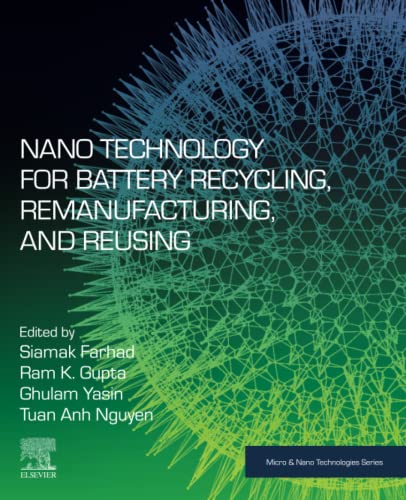
Product details:
ISBN 10:0323984932
ISBN 13:9780323984935
Author: Ram K. Gupta, Ghulam Yasin, Tuan Anh Nguyen
Nanotechnology for Battery Recycling, Remanufacturing, and Reusing explores how nanotechnology is currently being used in battery recycling, remanufacturing and reusing technologies to make them economically and environmentally feasible. The book shows how nanotechnology can be used to enhance and improve battery recycling, remanufacturing and reusing technologies, covering the fundamentals of battery recycling, remanufacturing and reusing technologies, the role of nanotechnology, the separation, regeneration and reuse of nanomaterials from battery waste, nano-enabled approaches for battery recycling, and nano-enabled approaches for battery remanufacturing and reusing.
Table of Contents:
- Section 1. General and technical aspects
- Chapter 1. Market batteries and their characteristics
- 1. Chemical battery
- 2. Physical battery
- 3. Current status of battery technology at home and abroad
- Chapter 2. Available technologies for remanufacturing, repurposing, and recycling lithium-ion batteries: an introduction
- 1. Introduction
- 2. State-of-health estimation
- 3. Remanufacturing
- 4. Repurposing
- 5. Recycling
- 6. Extraction of materials
- 7. Challenges and future trends
- 8. Conclusion
- Chapter 3. Nanotechnology and recycling, remanufacturing, and reusing battery
- 1. Introduction
- 2. Battery nanostructures
- 3. Processes for recovering and synthesizing nanomaterials
- 4. Nanotechnology for metal recovery from batteries
- 5. Synthesis of metallic nanoparticles and other materials
- 6. Future prospects
- Chapter 4. Promising technologies under development for recycling, remanufacturing, and reusing batteries: an introduction
- 1. Introduction
- 2. Ionic liquids
- 3. Supercritical fluids
- 4. Nanohydrometallurgy
- 5. Organic acids
- 6. Deep-eutectic solvents
- 7. Biohydrometallurgy
- 8. Conclusion
- Chapter 5. Innovative strategies for recycling used batteries for brighter future
- 1. Introduction
- 2. Need for recycling batteries
- 3. Strategies for recycling battery components
- 4. Conclusion
- Chapter 6. Battery recycling for sustainable future: recent progress, challenges, and perspectives
- 1. Introduction
- 2. Battery market
- 3. Battery recycling
- 4. Challenges and perspectives
- 5. Conclusion
- Section 2. Battery recycling and separation processes
- Chapter 7. Bio-inspired nanotechnology for easy-to-recycle lithium-ion batteries
- 1. Introduction
- 2. Combating interfacial delamination
- 3. Bio-inspired directional adhesives
- 4. Interface for easy-to-recycle batteries
- 5. Underlying mechanisms
- 6. Concluding remarks and future perspectives
- Chapter 8. Materials recycling using pH/thermal-responsive materials
- 1. Introduction
- 2. Recyclable pH-responsive nanomaterials
- 3. Recyclable thermo-responsive nanomaterials
- 4. Future trends
- 5. Conclusion
- Chapter 9. Pyrometallurgy-based applications in spent lithium-ion battery recycling
- 1. Introduction
- 2. Application of pyrometallurgy in pretreatment process
- 3. Pyrometallurgy technology
- 4. Summary and prospects
- Chapter 10. Application of hydrometallurgy in spent lithium-ion battery recycling
- 1. Introduction
- 2. Leaching technology
- 3. Separation and extraction technologies
- Chapter 11. Biohydrometallurgical recycling approaches for returning valuable metals to the battery production cycle
- 1. Introduction
- 2. Approaches for recycling spent lithium-ion batteries
- 3. Types of biohydrometallurgical methods
- 4. Microbes in bioleaching
- 5. Bioleaching mechanism
- 6. A brief summary of spent battery bioleaching
- 7. Reuse of valuable metals in battery production
- 8. Conclusion and perspectives
- Chapter 12. Technologies for separating nanomaterials from spent lithium-ion batteries
- 1. Introduction
- 2. Pretreatment process
- 3. Separation of nanomaterials from the collector fluid
- 4. Separation of nanomaterials
- Chapter 13. Separating battery nano/microelectrode active materials with the physical method
- 1. Introduction
- 2. Materials
- 3. Modeling
- 4. Results and discussion
- 5. Conclusions
- Nomenclature
- Abbreviations
- Section 3. Recycling battery materials
- Chapter 14. Recycling battery anode materials
- 1. Anode materials in lithium-ion batteries
- 2. The imperative of anode materials recycling
- 3. Graphite materials in lithium-ion batteries
- 4. Recycling methods for anode materials
- 5. Defects in industry recycling
- 6. Prospects and challenges
- Chapter 15. Recycling battery cathode materials
- 1. Introduction
- 2. Approaches for recycling battery cathode materials
- 3. Challenges and perspectives
- Chapter 16. Recycling battery metallic materials
- 1. Commercial batteries and recyclability of metallic materials
- 2. Technologies for metal recycling
- 3. Conclusion and future perspectives
- Chapter 17. Recycling battery casing materials
- 1. Introduction
- 2. Target
- 3. Structure of cell housings
- 4. Housing fraction and case disassembly
- 5. Generating the housing fraction by mechanical processing
- 6. Processing the housing fraction
- 7. Process flowchart
- 8. Summary
- Section 4. Battery remanufacturing and reusing
- Chapter 18. Regeneration technologies for electrode nanomaterials of recycled batteries
- 1. Introduction
- 2. Carbonaceous nanomaterials recycling
- 3. Metal nanomaterials recycling
- 4. Conclusions
- Chapter 19. LIB industry waste valorization for battery production
- 1. Introduction
- 2. Waste characterization
- 3. Cobalt extraction by acid leaching
- 4. Selective separation of cobalt by solvent extraction from LiCoO2 leach liquor
- 5. Valorization through oxide synthesis
- 6. Process development
- 7. Conclusions
- Chapter 20. Recycling lithium, cobalt, and nickel for return to the battery production cycle
- 1. Direct repair
- 2. Extraction of metal followed by material regeneration
- Chapter 21. Effects of imperfect separation of recycled cathode active materials on remanufactured lithium-ion battery performance
- 1. Introduction
- 2. Brief summary of the mathematical model
- 3. Experiments
- 4. Results and discussion
- 5. Conclusions
- Chapter 22. Mechanical and physical processes of battery recycling
- 1. Introduction
- 2. Lithium-ion batteries
- 3. Physical processing of end-of-life lithium-ion batteries
- 4. Process groups
- 5. Conclusion
People also search:
nano technology for battery recycling remanufacturing and reusing
what is nano battery
battery recycling techniques
nano technology battery
nano tech batteries
Tags:
Nano Technology,Battery Recycling,Remanufacturing,Reusing,Ram Gupta,Ghulam Yasin,Tuan Anh Nguyen
You may also like…
Uncategorized
Technique - Nanotechnology
Engineering - Industrial Engineering & Materials Science
Nanostructured Materials for Visible Light Photocatalysis (Micro and Nano Technologies) 1st Edition
Uncategorized


